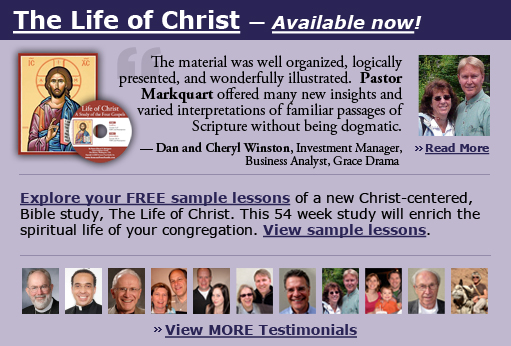
Christmas
Easter
Pentcoest
All Saints
Christ The King
Confirmation
Palm/Passion
Reformation
Stewardship
Books of the Bible
Lenten Series
Christmas Dramas
Videos
Series A - Matthew
Series B - Mark
Series C - Luke
Series D - Other
To contact
Edward F. Markquart
info@sfs.com

Series B The Pedalavium (The Foot Washing): A Re-enactment John 13:1-17 Setting: A chair is placed in the center of the chancel area, in front of the communion table. There is a long white towel hanging from the arm of the chair, or hanging from the communion table. In front of the chair there is a large white bowl. On the communion table there is large pitcher filled with water. A representative person from the congregation comes forward barefoot and is seated in the chair. This person embodies the qualities of a servant within the community. The pastor steps forward and stands near the water basin. The pastor addresses the congregation saying, "Tonight is Holy Thursday. Tonight is a very sacred night in the Christian Church. At the Last Supper, in the Gospe1 of John, we read about the footwashing of the disciples. In the first three gospels, Matthew, Mark and Luke, the most important event at the Last Supper is Holy Communion, the sharing of the bread and wine. But in the Gospel of John, the most sacred event of the Last Supper is the footwashing. There is no Holy Communion during the Last Supper in the Gospel of John. In the Gospel of John, the footwashing is the final symbolic act that Jesus did with his disciples at the Last Supper. Tonight I would like to re-enact for you the footwashing as an example of what Jesus did at the Last Supper, as recorded in the Gospel of John. The gospel lesson for Maundy Thursday is John 13. John, chapter 13, is the story of the footwashing or what has been called, “The Pedalavium,” “peda” – meaning foot, “lavi” meaning to bathe or wash. This footwashing, the Pedalavium, is being re-enacted tonight in many different settings throughout the world. In the Greek Orthodox church tonight, the archbishop is washing the feet of twelve poor people. In Rome tonight, the Pope is washing the feet of twelve of his priests. Historically on this night, Queen Mother Elizabeth washed the feet of twelve of her subjects to remind English citizens and herself that the queen was to be a servant of the people As the disciples were eating the last meal together, they started to argue among themselves, who was the greatest. Perplexed by their conversation, Jesus stood up. The disciples wondered what Jesus was doing. Jesus took off his outer garment (which looked similar to the alb that I am presently wearing) and he took a towel (from the arm of the chair) and wrapped it around his waist. The towel was most likely the towel of a servant who would normally wash the feet of the disciples as they entered the room. Jesus took the towel and wrapped it around his waist. (The pastor wraps the long white towel around his waist.) Jesus then took a pitcher of water and poured it into a bowl. (The pastor then pours the water into the bowl.) Jesus then proceeded to wash the disciples’ feet, one by one. The disciples, who had been arguing with each other about who was the greatest, became quiet, very quiet as no one spoke a word. When Jesus came to, Simon Peter, Peter asked, “Lord, Are you going to wash my feet?" Jesus answered, "Yes, Simon, I am going to wash your feet." Simon replied, “Never, Lord. You are not going to wash me. It is not right for a master to wash the feet of his disciple.” Jesus said to Simon, "If I cannot wash you and make you clean, you cannot truly be my follower." Simon begged, “Lord, wash all of me! Wash my hands, my legs, my arms! Wash all of me that I may be truly clean and be your disciple.” And Jesus washed the feet of Simon. (The pastor then kneels down and begins to wash the feet of the congregational member seated in front of him. As the feet are being washed, the pastor continues:) At this point in the footwashing, in the early church, a passage from Philippians 2:5-11 was read. “For Christ did not count equality with God a thing to be grasped, but Christ humbled himself taking the form of a servant. He was humble and obedient unto death.” “A new commandment I give to you, that you love one another as I have loved you. This is my new mandate, my new commandment, that you love one another.” (The pastor then stands and faces the congregation and says), Jesus concluded the footwashing by looking at his disciples and saying, “How happy you will be if you put this into practice. How happy you will be if you live a life of service and humility.” This concludes the Pedalavium. (The pastor then steps back and takes the long white towel and places it around his neck as a stole and continues), In one tradition in the early church the towel of servanthood was then placed on the shoulder of the pastor (like this) and eventually became the stole, the symbol of ordination. The pastor’s stole, in spite of all its color and designs, is essentially and simply a towel, a dishtowel of servanthood. A follower of Jesus Christ is always a servant of others.” (The person whose feet have been washed now returns to his place in the congregation. The pastor proceeds to the communion table and begins the liturgy for the Sacrament of the Altar.) |